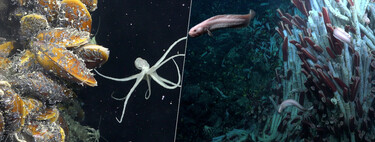The “yellow road” that guided Dorothy in The Wizard of Oz was not over the rainbow but under the water. This is what those responsible for a unique find geological in 2022 when, in the middle of the expedition, its cameras collected images of a unique geological formation.
The yellow road. “Follow the ‘yellow path’ towards the geological formations of the Liliʻuokalani underwater mountain range,” the team headlined. the press release in which he recorded the singular discovery.
The “path” they had found was not, in fact, anything from a magical world, but one of the underwater geological formations that can be found in the Papahānaumokuākea Marine National Monument (PMNM), the protected underwater area surrounding the Leeward Islands , the western extension of the Hawaiian archipelago.
The unique thing about this geological formation is its appearance similar to that of cobblestone: with a surface composed of rocks with a smooth and (more or less) rectangular surface. “It’s like a roasted crust”, “yeah, like you could peel [la roca]”, they comment in a video the researchers who control the submersible vehicle from which they analyzed the seabed.
Unique geology. According to the team explained In a press release, the terrain corresponded to a formation known as “dry lake bed” (dried lake bed). The study of the environment revealed that the rock that formed this bed was hyaloclastitea rock of volcanic origin that is formed in high-energy eruptions that deposit numerous fragments on the seabed.
The unique “brick” appearance of the rocks was, the expedition team added, probably due to the stress generated by heating and cooling during various volcanic eruptions. The team found numerous volcanic rocks along their path, including simple basalts coated with ferromanganese, they add.
Luʻuaeaahikiikekumu 2022. The discovery was made in the context of the Luʻuaeaahikiikekumu 2022 expedition, carried out by the E/V Nautilus ship. The expedition, funded by NOAA (National Oceanic and Atmospheric Administration) and organized by Ocean Exploration Trust (OET), took place between April 7 and May 1, 2022, with the aim of continuing the work developed by a precursor expedition in October of the previous year.
The objective of the expedition, those responsible explainedwas to collect samples with which to determine both the geological origin and the age of underwater geological formations. Beyond the unique geology of the area, the expedition also sought to study the biodiversity of the area, with special emphasis on coral and sponge communities, they added.
E/V Nautilus. He Nautilus oceanographic vessel It was built in the German Democratic Republic in the late 1960s. OET acquired it in 2008, shortly after the association’s creation. The ship is 68 meters long and has the capacity to deploy ROV submarines, remotely operated unmanned vehicles.
In Xataka | If you have a marine sound that you don’t know how to identify, perhaps NOAA and Google can give you a hand
Image | Ocean Exploration Trust







![[Img #74683]](https://thelatestnews.world/wp-content/uploads/2024/12/The-main-mistakes-to-avoid-when-betting-on-electronic-sports-150x150.jpg)





![[Img #74683]](https://thelatestnews.world/wp-content/uploads/2024/12/The-main-mistakes-to-avoid-when-betting-on-electronic-sports-300x200.jpg)


Add Comment